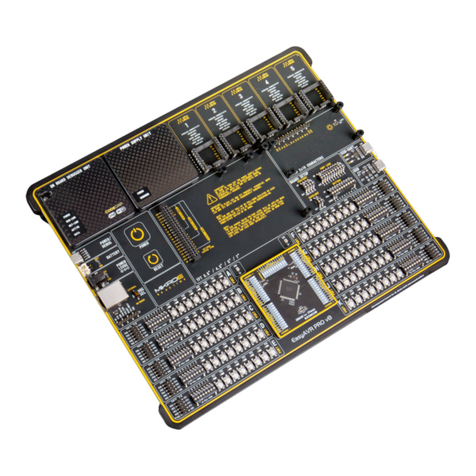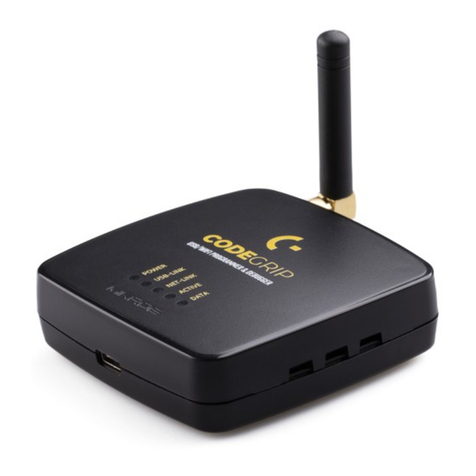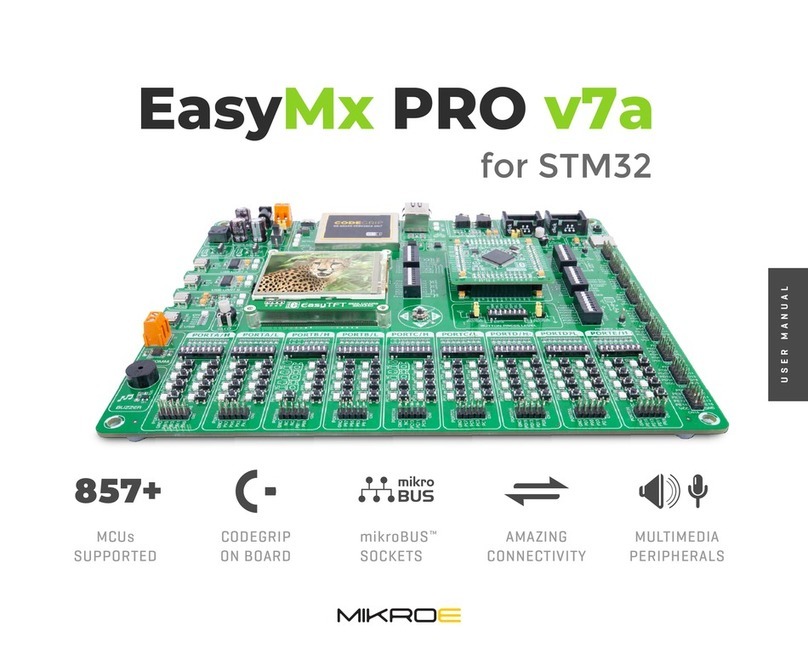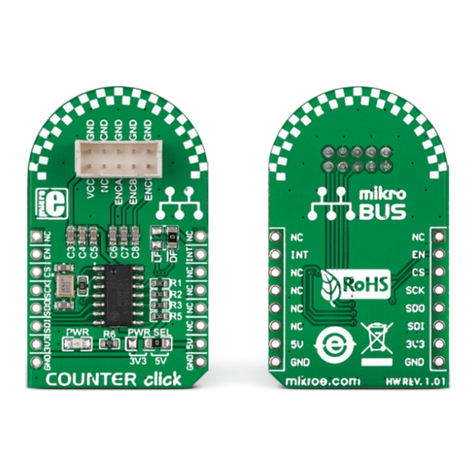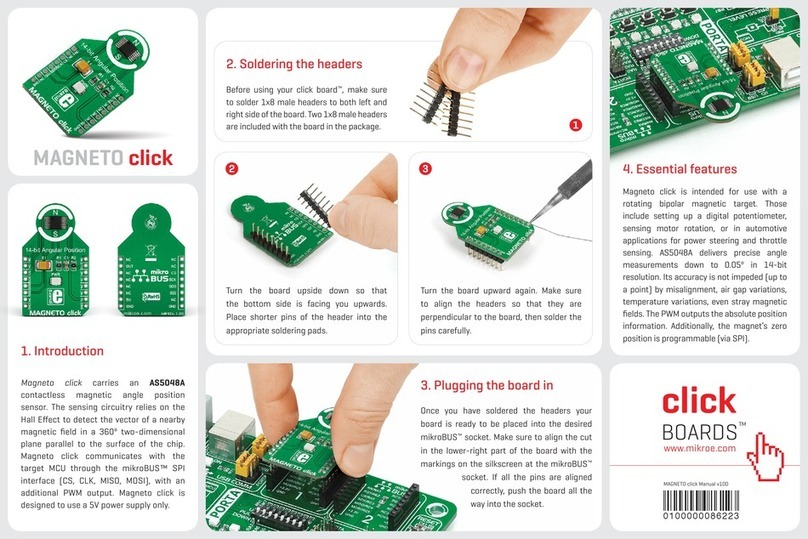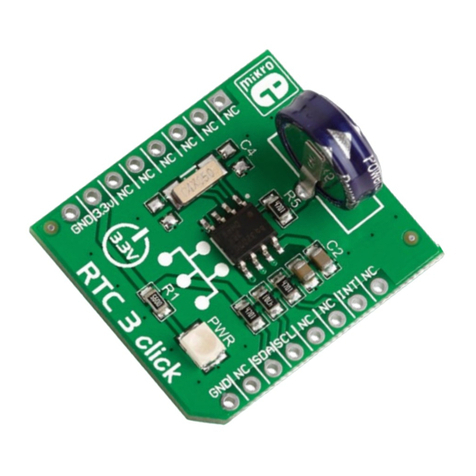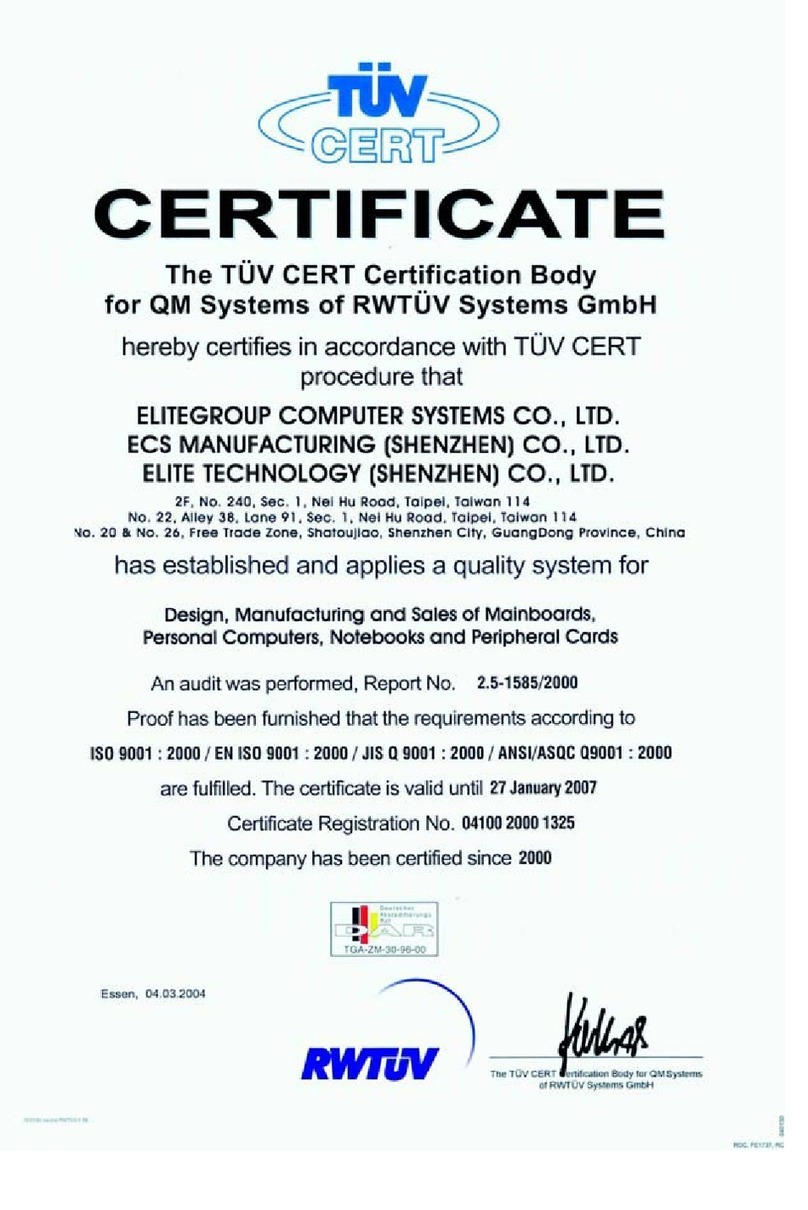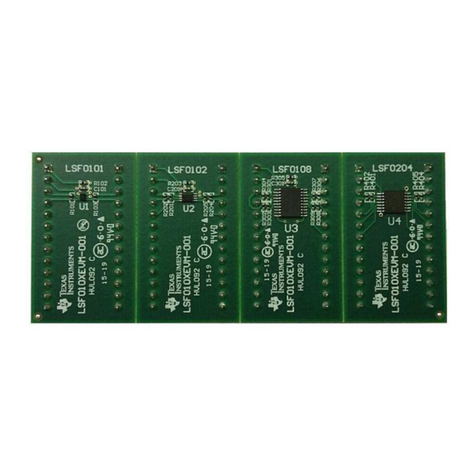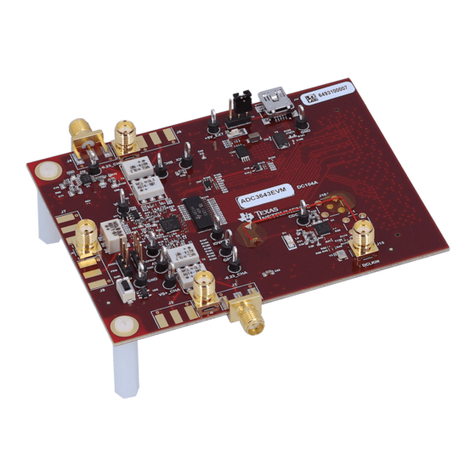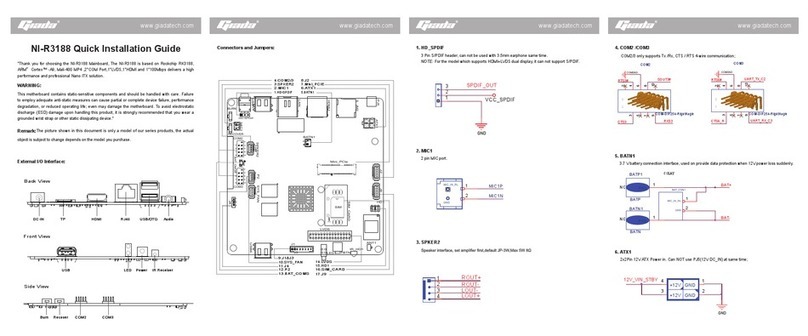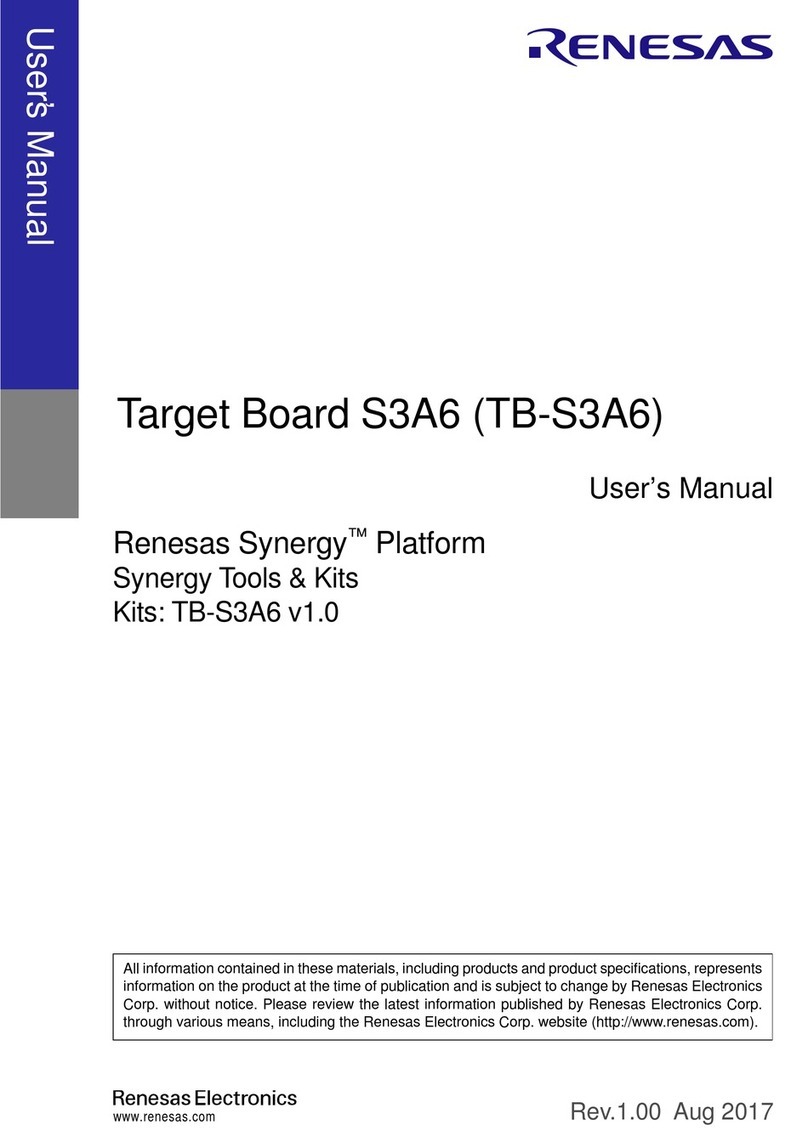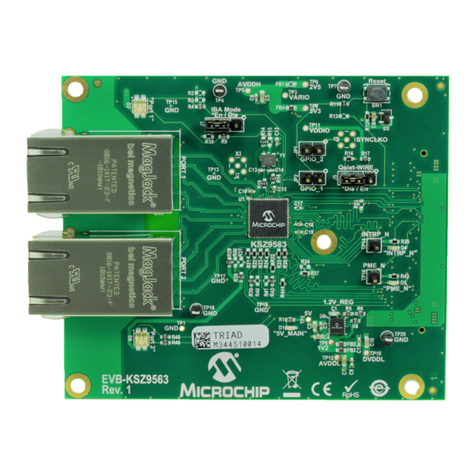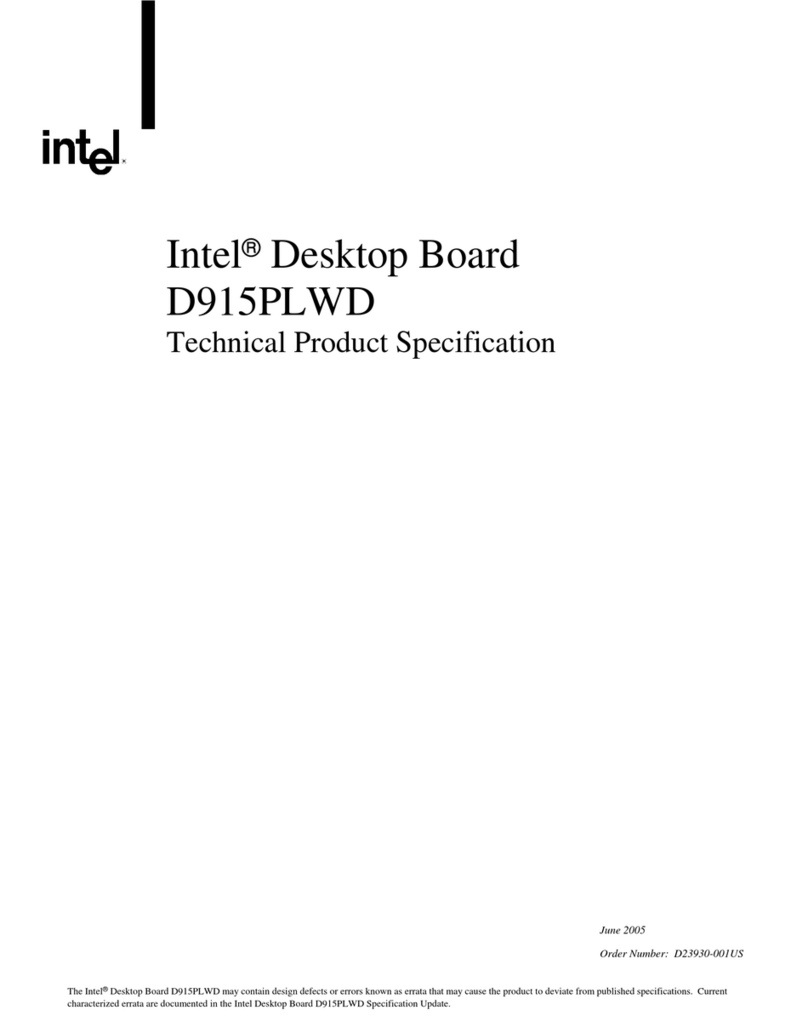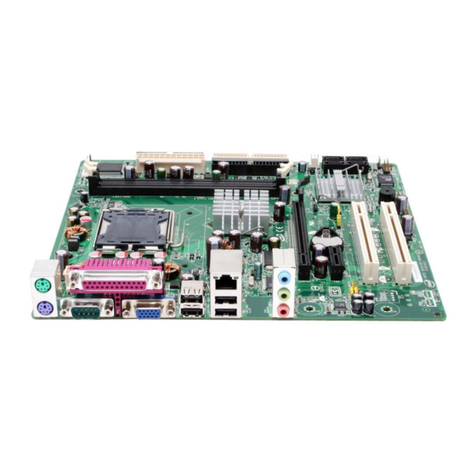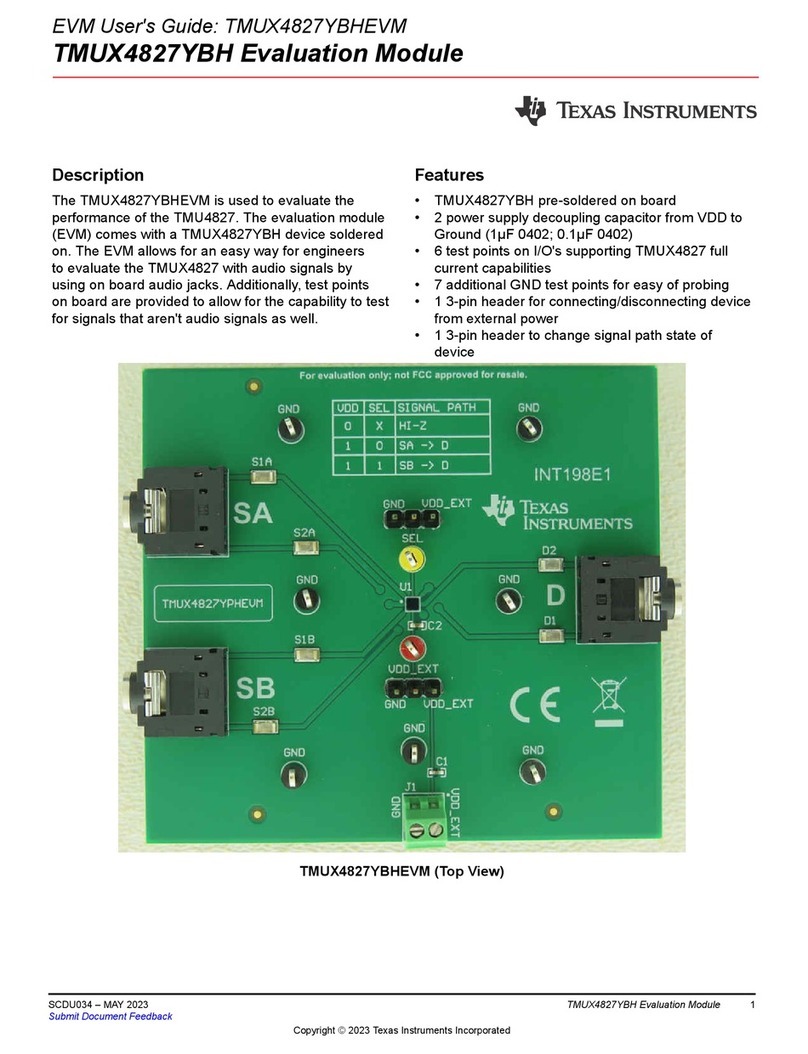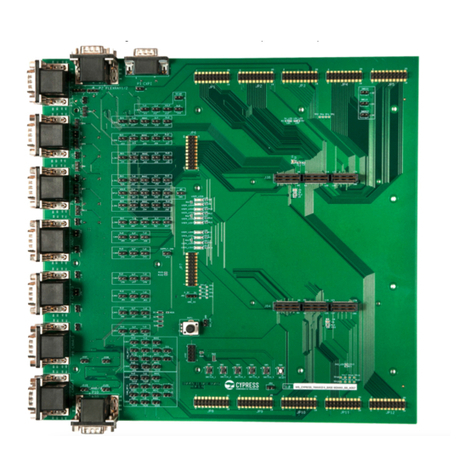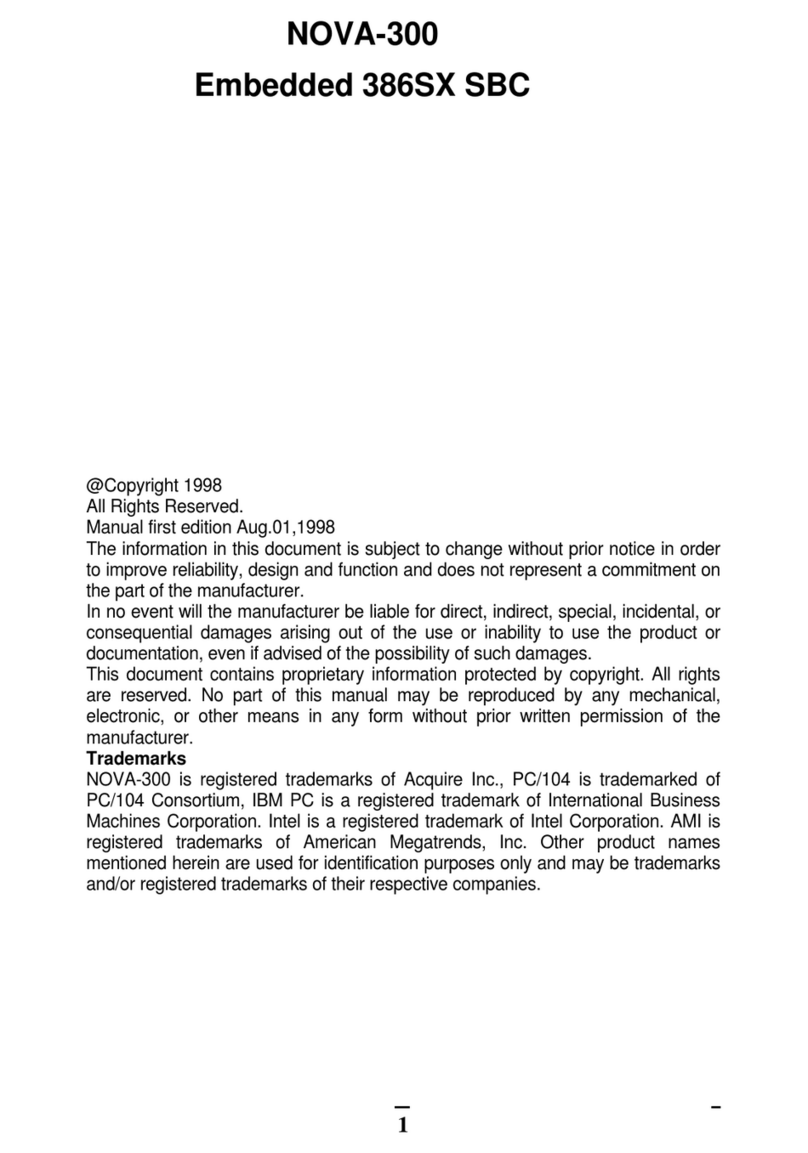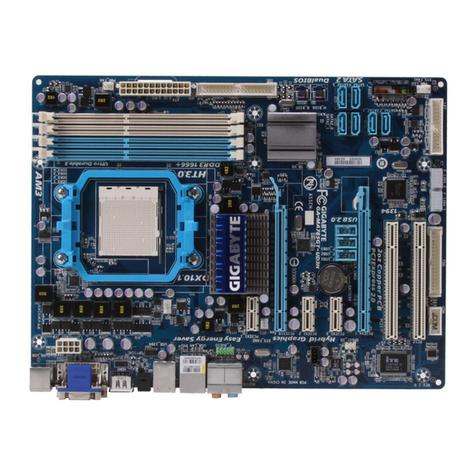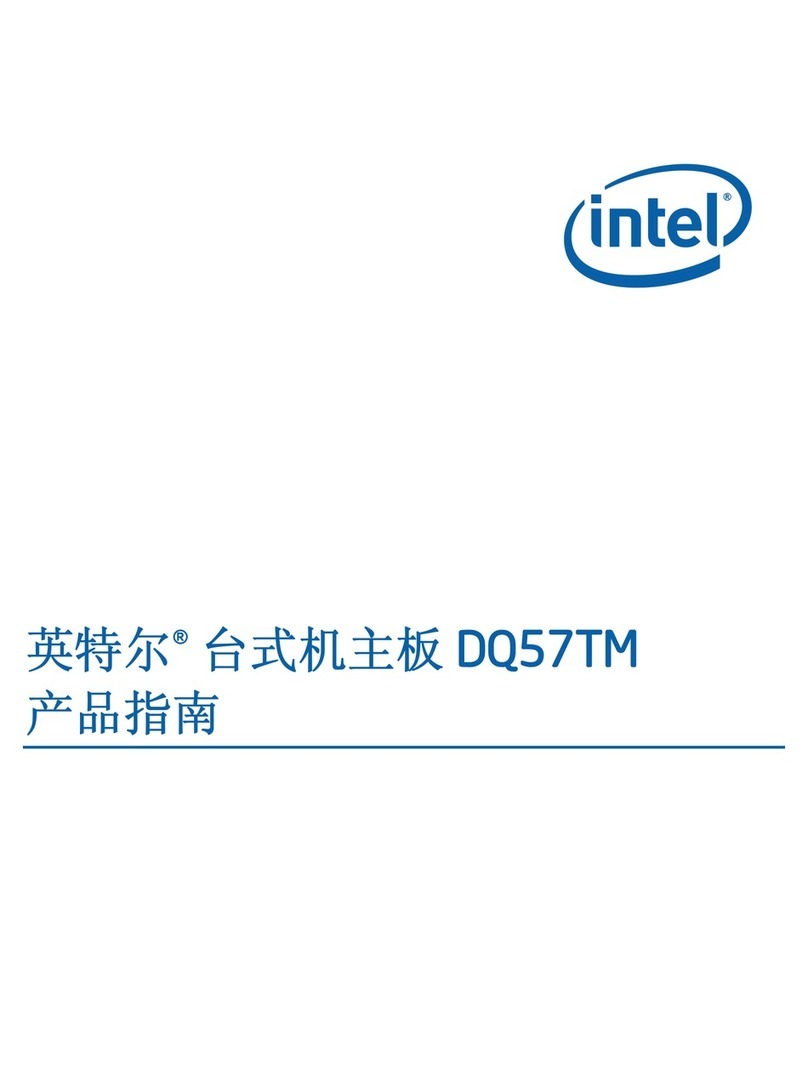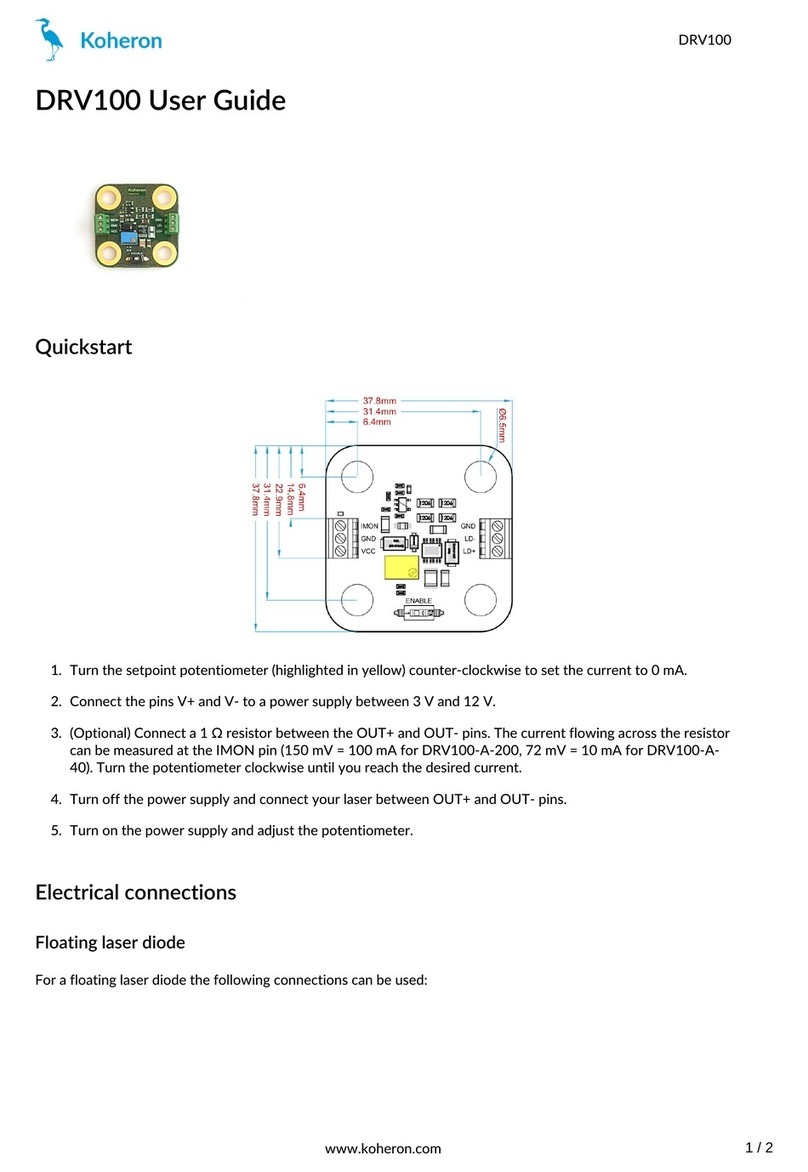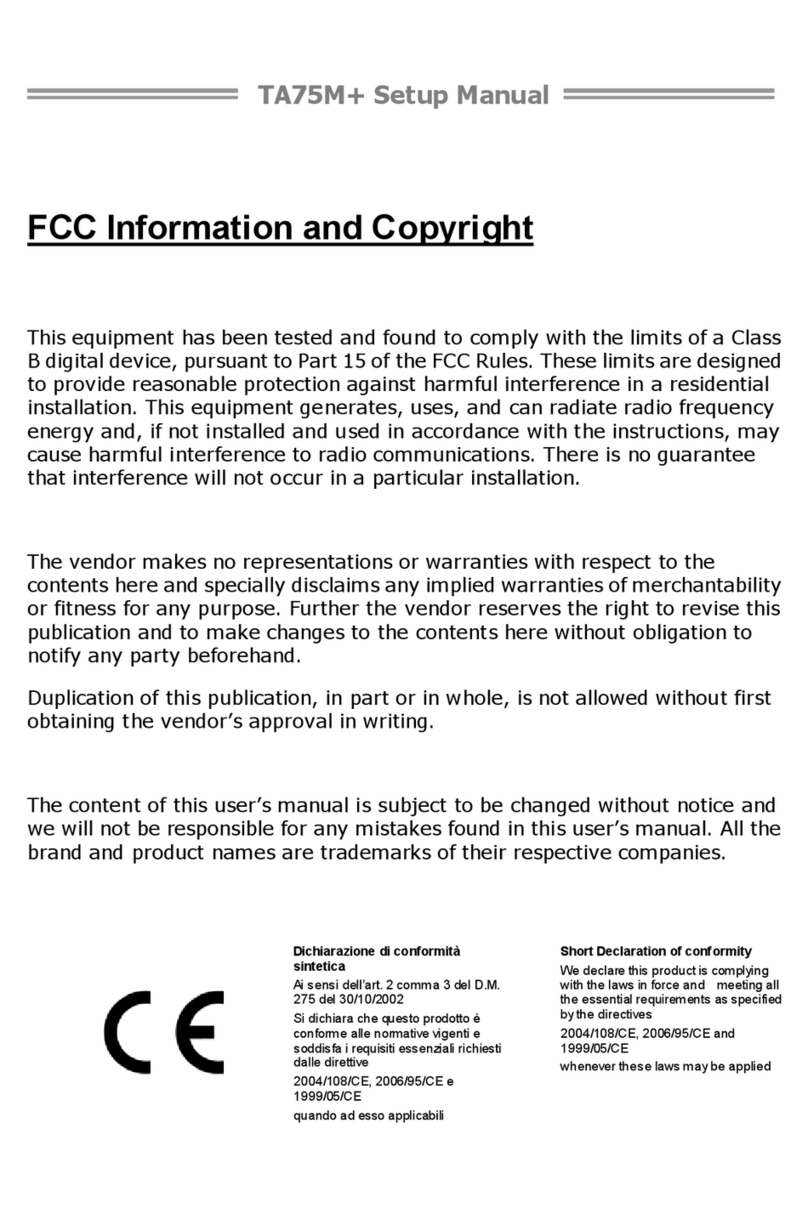Mikroe Mikromedia 4 User manual

P A G E 1
mikromedia 4 for PIC CAPACITIVE FPI U S E R M A N U A L
USER MANUAL
for PIC CAPACITIVE FPI

Thank you for choosing MIKROE!
We present you the ultimate multimedia solution for embedded development.
Elegant on the surface, yet extremely powerful on the inside, we have designed it to inspire outstanding achievements.
And now, it’s all yours.
Enjoy premium.
Time-saving embedded tools

Introduction 5
1.Key microcontroller features 6
1.1 MCU programming/debugging 8
1.2 MCU reset 8
2. Power supply unit 10
2.1 Detailed description 11
2.2 Voltage reference 11
2.3 PSU connectors 12
2.4 Power redundancy & UPS 15
2.5 Powering up the board 15
3. Capacitive display 16
4. Data storage 19
4.1 microSD card slot 19
4.2 External flash storage 19
5. Connectivity 20
5.1 RF 20
5.2 USB 21
5.3 mikroBUS™ shuttle connectors 22
6. Sound-related peripherals 24
6.1 Piezo buzzer 24
6.2 Audio CODEC 25
7. Sensors and other peripherals 26
7.1 Digital motion sensor 26
7.2 Real-time clock (RTC) 27
What’s next 30
Table of contents

Pick your own look
Identical in the back, choices up front.
mikromedia 4 for PIC Capacitive FPI with bezel
mikromedia 4 for PIC Capacitive FPI with frame
1
1
2
2

mikromedia 4 for PIC CAPACITIVE FPI is a compact development
board designed as a complete solution for the rapid development
of multimedia and GUI-centric applications. By featuring a 4.3”
capacitive touch screen driven by the powerful graphics controller
that can display the 24-bit color palette (16.7 million colors), along
with a DSP-powered embedded sound CODEC IC, represents a
perfect solution for any type of multimedia application.
At its core, there is a powerful 8-bit PIC18F97J94 microcontroller
(referred to as “host MCU” in the following text), produced by
Microchip, which provides sufficient processing power for the most
demanding tasks, ensuring fluid graphical performance and glitch-
free audio reproduction.
However, this development board is not limited to multimedia-based
applications only: mikromedia 4 for PIC CAPACITIVE FPI (“mikromedia
4 FPI” in the following text) features USB, RF connectivity options,
digital motion sensor, piezo-buzzer, battery charging functionality,
SD-Card reader, RTC, and much more, expanding its use beyond
the multimedia. Two compact-sized mikroBUS Shuttle connectors
represent the most distinctive connectivity feature, allowing access
to a huge base of Click boards™, growing on a daily basis.
The usability of mikromedia 4 FPI does not end with its ability to
accelerate the prototyping and application development stages: it
is designed as the complete solution which can be implemented
directly into any project, with no additional hardware modifications
required. We offer two types of mikromedia 4 for PIC CAPACITIVE
FPI boards. The first one has a TFT display with a bezel around it
and is ideal for handheld devices. The other mikromedia 4 for PIC
CAPACITIVE FPI board has a TFT display with a metal frame, and four
corner mounting holes that enable simple installation in various kinds
of industrial appliances. Each option can be used in smart home
solutions, as well as wall panel, security and automotive systems,
factory automation, process control, measurement, diagnostics and
many more. With both types, a nice casing is all that you need to turn
the mikromedia 4 for PIC CAPACITIVE FPI board into a fully functional
design.
Pick your own look
Identical in the back, choices up front.
mikromedia 4 for PIC Capacitive FPI with bezel
mikromedia 4 for PIC Capacitive FPI with frame
N O T EThis manual, in its entirety, showcases just one option of mikromedia
4 for PIC CAPACITIVE FPI for illustration purposes. The manual applies
to both options.

P A G E 6
mikromedia 4 for PIC CAPACITIVE FPI U S E R M A N U A L
PIC18F97J94
1. Key microcontroller features
PIC18F97J94 is the high-performace 8-bit MCU, produced
by Microchip. It features a rich peripheral set, like CTMU,
hardware RTC, 12 bit A/D, along with the standard ones. Key
features include:
∫128 MB of Flash memory
∫4 KB of RAM memory
∫nanoWatt XLP technology
∫Operating frequency up to 64 MHz
∫High-Precision PLL for USB
For the complete list of MCU features, please refer to the
PIC18F97J94 datasheet.
At its core, mikromedia 4 for PIC CAPACITIVE FPI uses the PIC18F97J94 MCU.
PIC18F97J94
Figure 1: PIC18F97J94 MCU block schematic

P A G E 7
mikromedia 4 for PIC CAPACITIVE FPI U S E R M A N U A L
MCUs FEATURES

P A G E 8
mikromedia 4 for PIC CAPACITIVE FPI U S E R M A N U A L
MCUs FEATURES
1
2
3
Figure 3: Front and back partial view
The host MCU (1) can be programmed and debugged over the Microchip
ICSP compatible 2x5 pin header (2), labeled as PROG/DEBUG. This header
allows an external programmer (e.g. CODEGRIP or mikroProg) to be used.
Programming the microcontroller can also be done by using the bootloader
which is preprogrammed into the device by default. All the informations
about the bootloader software can be found on the following page:
www.mikroe.com/mikrobootloader
The board is equipped with the Reset button (3), which is located on the
back side of the board. It is used to generate a LOW logic level on the
microcontroller reset pin.
1.1 Microcontroller programming/debugging
1.2 MCU reset

P A G E 9
mikromedia 4 for PIC CAPACITIVE FPI U S E R M A N U A L

P A G E 10
mikromedia 4 for PIC CAPACITIVE FPI U S E R M A N U A L
The power supply unit (PSU) provides clean and regulated
power, necessary for proper operation of the mikromedia 4 FPI
development board. The host MCU, along with the rest of the
peripherals, demands regulated and noise-free power supply.
Therefore, the PSU is carefully designed to regulate, filter,
and distribute the power to all parts of mikromedia 4 FPI. It
is equipped with three different power supply inputs, offering
all the flexibility that mikromedia 4 FPI needs, especially
when used on the field or as an integrated element of a larger
system. In the case when multiple power sources are used, an
automatic power switching circuit with predefined priorities
ensures that the most appropriate will be used.
The PSU also contains a reliable and safe battery charging
circuit, which allows a single-cell Li-Po/Li-Ion battery to be
charged. Power OR-ing option is also supported, providing
an uninterrupted power supply (UPS) functionality when an
external or USB power source is used in combination with the
battery.
2. Power supply unit
Figure 4: Power supply unit view
mikromedia 4 for PIC CAPACITIVE FPI U S E R M A N U A L

P A G E 11
mikromedia 4 for PIC CAPACITIVE FPI U S E R M A N U A L
2.1 Detailed description
POWER SUPPLY
The PSU has a very demanding task of providing power for the host MCU
and all the peripherals onboard, as well as for the externally connected
peripherals. One of the key requirements is to provide enough current,
avoiding the voltage drop at the output. Also, the PSU must be able to
support multiple power sources with different nominal voltages, allowing
switching between them by priority. The PSU design, based on a set of
high-performance power switching ICs produced by Microchip, ensures a
very good quality of the output voltage, high current rating, and reduced
electromagnetic radiation.
At the input stage of the PSU, the MIC2253, a high-efficiency boost regulator
IC with overvoltage protection ensures that the voltage input at the next
stage is well-regulated and stable. It is used to boost the voltage of low-
voltage power sources (a Li-Po/Li-Ion battery and USB), allowing the next
stage to deliver well-regulated 3.3V and 5V to the development board. A set
of discrete components are used to determine if the input power source
requires a voltage boost. When multiple power sources are connected
at once, this circuitry is also used to determine the input priority level:
externally connected 12V PSU, power over USB, and the Li-Po/Li-Ion battery.
The transition between available power sources is designed to provide
uninterrupted operation of the development board.
The next PSU stage uses two MCP16331, highly integrated, high-efficiency,
fixed frequency, step-down DC-DC converters, capable of providing up
to 1.2A. Each of the two buck regulators is used to supply power to the
corresponding power supply rail (3.3V and 5V), throughout the entire
development board and connected peripherals.
The MCP1501, a high-precision buffered voltage reference from Microchip
is used to provide a very precise voltage reference with no voltage drift. It
can be used for various purposes: the most common uses include voltage
references for A/D converters, D/A converters, and comparator peripherals
on the host MCU. The MCP1501 can provide up to 20mA, limiting its use
exclusively to voltage comparator applications with high input impedance.
Depending on the specific application, either 3.3V from the power rail,
or 2.048V from the MCP1501 can be selected. An onboard SMD jumper
labeled as REF SEL offers two voltage reference choices:
∫REF: 2.048V from the high-precision voltage reference IC
∫3V3: 3.3V from the main power supply rail
2.2 Voltage reference

P A G E 12
mikromedia 4 for PIC CAPACITIVE FPI U S E R M A N U A L
2.3 PSU connectors
The USB-C connector (labeled as CN7) provides power from the USB host
(typically PC), USB power bank, or USB wall adapter. When powered over the
USB connector, the available power will depend on the source capabilities.
As explained, the advanced design of the PSU allows several types of power
sources to be used, offering unprecedented flexibility: when powered by
a Li-Po/Li-Ion battery, it offers an ultimate degree of autonomy. For
situations where the power is an issue, it can be powered by an external
12VDC power supply, connected over the two-pole screw terminal. Power is
not an issue even if it is powered over the USB cable. It can be powered over
the USB-C connector, using power supply delivered by the USB HOST (i.e.
personal computer), USB wall adapter, or a battery power bank.
There are three power supply connectors available, each with its unique
purpose:
∫CN7: USB-C connector (1)
∫TB1: Screw terminal for an external 12VDC PSU (2)
∫CN6: Standard 2.5mm pitch XH battery connector (3)
2.3.1 USB-C connector
12 3
Figure 5: Power supply connectors view

P A G E 13
mikromedia 4 for PIC CAPACITIVE FPI U S E R M A N U A L
POWER SUPPLY
An external 12V power supply can be connected over the 2-pole screw
terminal (labeled as TB1). When using an external power supply, it is
possible to obtain an optimal amount of power, since one external power
2.3.2 12VDC screw terminal
Figure 6: USB power supply table
Figure 7: External power supply table
USB power supply
Input Voltage [V] Output Voltage [V]
3.3
5
3.3 & 5
1.2
1.2
0.7 & 0.7
3.96
6
5.81
Max Current [A] Max Power [W]
MIN
4.4 5.5
MAX
External power supply
Input Voltage [V] Output Voltage [V]
3.3
5
3.3 & 5
1.2
1.2
1.2 & 1.2
3.96
6
9.96
Max Current [A] Max Power [W]
MIN
10.6 14
MAX
When using a PC as the power source, the maximum power can be obtained
if the host PC supports the USB 3.2 interface, and is equipped with USB-C
connectors. If the host PC uses the USB 2.0 interface, it will be able to
provide the least power, since only up to 500 mA (2.5W at 5V) is available
in that case. Note that when using longer USB cables or USB cables of low
quality, the voltage may drop outside the rated operating voltage range,
causing unpredictable behavior of the development board.
N O T E
N O T E
If the USB host is not equipped with the USB-C connector, a Type A to
Type C USB adapter may be used (included in the package).
When connecting an external power supply over the screw terminal,
make sure that the polarity of the wires is matched with the 12VDC
connector on the development board, according to the marked pins
of screw terminal.
Maximum power ratings, along with the allowed input voltage range in the
case when the USB power supply is used, are given in the table Figure 6:
supply unit can be easily exchanged with another, while its power and
operating characteristics can be decided per application. The development
board allows a maximum current of 1.2A per power rail (3.3V and 5V) when
using an external 12V power supply. The screw terminal is a good choice
when there is no connector installed at the end of the PSU cable.
Maximum power ratings, along with the allowed input voltage range in the
case when the external power supply is used, are given in the table Figure 7:

P A G E 14
mikromedia 4 for PIC CAPACITIVE FPI U S E R M A N U A L
When powered by a single-cell Li-Po/Li-Ion battery, mikromedia 4 FPI
offers an option to be operated remotely. This allows complete autonomy,
allowing it to be used in some very specific situations: hazardous
environments, agricultural applications, etc.
The battery connector is a standard 2.5mm pitch XH connector. It allows
a range of single-cell Li-Po and Li-Ion batteries to be used. The PSU of
mikromedia 4 FPI offers the battery charging functionality, from both the
USB connector and the 12VDC/external power supply. The battery charging
circuitry of the PSU manages the battery charging process, allowing the
optimal charging conditions and longer battery life. The charging process
is indicated by BATT LED indicator, located on the back of mikromedia 4 FPI.
The PSU module also includes the battery charger circuit. Depending
on the operational status of the mikromedia 4 FPI development board,
the charging current can be either set to 100mA or 500mA. When the
development board is powered OFF, the charger IC will allocate all available
power for the battery charging purpose. This results in faster charging, with
the charging current set to approximately 500mA. While powered ON, the
available charging current will be set to approximately 100 mA, reducing
the overall power consumption to a reasonable level.
2.3.3 Li-Po/Li-Ion XH battery connector
Maximum power ratings along with the allowed input voltage range when
the battery power supply is used, are given in the table Figure 8:
Figure 8: Battery power supply table
Battery power supply
Input Voltage [V] Output Voltage [V]
3.3
5
3.3 & 5
1.2
1.1
0.6 & 0.6
3.96
5.5
4.98
Max Current [A] Max Power [W]
MIN
3.5 4.2
MAX
N O T E Using low-quality USB hubs, and too long or low-quality USB cables,
may cause a significant USB voltage drop, which can obstruct the
battery charging process.
P A G E 14 POWER SUPPLY

2.4 Power redundancy and
uninterrupted power supply (UPS)
2.5 Powering up the
mikromedia 4 FPI board
The PSU module supports power supply redundancy: it will automatically
switch to the most appropriate power source if one of the power sources
fails or becomes disconnected. The power supply redundancy also allows
for an uninterrupted operation (i.e. UPS functionality, the battery will still
provide power if the USB cable is removed, without resetting mikromedia 4
FPI during the transition period).
After a valid power supply source is connected (1) in our case with a single-
cell Li-Po/Li-Ion battery, mikromedia 4 FPI can be powered ON. This can
be done by a small switch at the edge of the board, labeled as SW1 (2).
By switching it ON, the PSU module will be enabled, and the power will be
distributed throughout the board. A LED indicator labeled as PWR indicates
that the mikromedia 4 FPI is powered ON.
POWER SUPPLY
P A G E 15
Figure 9: Battery power supply connection
12

P A G E 16
mikromedia 4 for PIC CAPACITIVE FPI U S E R M A N U A L
CAPACITIVE DISPLAY
3. Capacitive display
A high-quality 4.3” TFT true-color display with a capacitive
touch panel is the most distinctive feature of the mikromedia 4.
The display has a resolution of 480 by 272 pixels, and it can
display up to 16.7M of colors (24-bit color depth). The display
of mikromedia 4 features a reasonably high contrast ratio
of 500:1, thanks to 10 high-brightness LEDs used for the
backlighting.
The display module is controlled by the FT813 (1) graphics
driver IC from FTDI. This is a powerful graphics controller
targeted at embedded applications to generate high-quality
Human Machine Interfaces (HMIs). It also includes some
advanced features such as the embedded video engine,
enhanced sketch processing, built-in synthesizer, and more.
The capacitive multi-touch panel, based on the FT5216 CTP
controller, allows the development of interactive applications,
offering a touch-driven control interface. The touch panel
controller uses the I2C interface for the communication
with the host controller. This advanced multi-touch panel
controller supports gestures, including zoom and swipe in all
four directions.
Equipped with high-quality 4.3” display (2) and the multi-
touch controller that supports gestures, mikromedia 4
represents a very powerful hardware environment for
building various GUI-centric Human Machine Interface (HMI)
applications.

1
2
Figure 10: Display and FT813 view

P A G E 18
mikromedia 4 for PIC CAPACITIVE FPI U S E R M A N U A L
12 Figure 11: MicroSD card slot and Flash memory view

P A G E 19
mikromedia 4 for PIC CAPACITIVE FPI U S E R M A N U A L
DATA STORAGE
4.1 microSD card slot 4.2 External flash storage
The microSD card slot (1) allows storing large amounts of data externally,
on a microSD memory card. It uses the Serial Peripheral Interface (SPI) for
communication with the MCU. The microSD card detection circuit is also
provided on the board. The microSD card is the smallest SD Card version,
measuring only 5 x 11 mm. Despite its small size, it allows tremendous
amounts of data to be stored on it. In order to read and write to the SD
Card, a proper software/firmware running on the host MCU is required.
mikromedia 4 FPI is equipped with the SST26VF064B Flash memory (2).
The Flash memory module has a density of 64 Mbits. Its storage cells are
arranged in 8-bit words, resulting in 8Mb of non-volatile memory in total,
available for various applications. The most distinctive features of the
SST26VF064B Flash module are its high speed, very high endurance, and
very good data retention period. It can withstand up to 100,000 cycles, and
it can preserve the stored information for more than 100 years. It also uses
the SPI interface for the communication with the MCU.
4. Data storage
The mikromedia 4 FPI development board is equipped with two types of storage memory: with a microSD card slot and a Flash
memory module.

mikromedia 4 FPI offers communication over the world-wide ISM radio band.
The ISM band covers a frequency range between 2.4GHz and 2.4835GHz. This
frequency band is reserved for industrial, scientific, and medical use (hence
the ISM abbreviation). In addition, it is globally available, making it a perfect
alternative to WiFi, when the M2M communication over a short distance is
required.
mikromedia4FPIusesthenRF24L01+(1), asingle-chip2.4GHztransceiver with
an embedded baseband protocol engine, produced by Nordic Semiconductors.
It is a perfect solution for ultra-low power wireless applications. This transceiver
relies on the GFSK modulation, allowing data rates in the range from 250 kbps,
up to 2 Mbps. The GFSK modulation is the most efficient RF signal modulation
1
P A G E 20 CONNECTIVITY
mikromedia 4 for PIC CAPACITIVE FPI U S E R M A N U A L
5. Connectivity
mikromedia 4 FPI offers a huge number of connectivity options.
It includes support for the RF and USB (DEVICE). Besides those
options, it also offers two standardized mikroBUS™Shuttle
connectors. It is a considerable upgrade for the system, as it
allows interfacing with the huge base of Click boards™.
5.1 RF
Other manuals for Mikromedia 4
2
Table of contents
Other Mikroe Motherboard manuals
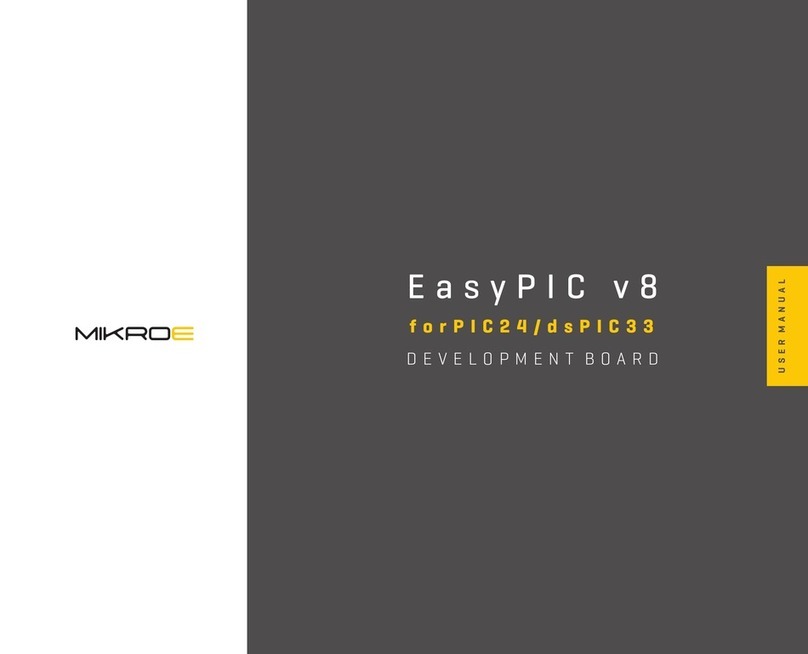
Mikroe
Mikroe EasyPIC V8 User manual
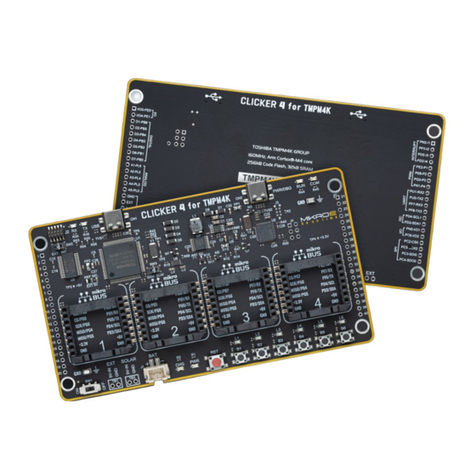
Mikroe
Mikroe CLICKER 4 For TMPM4K User manual
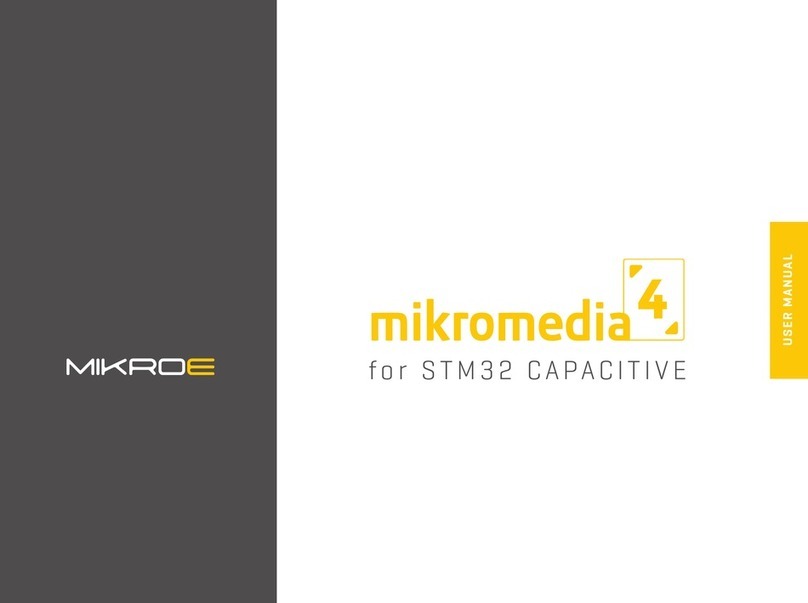
Mikroe
Mikroe Mikromedia 4 User manual
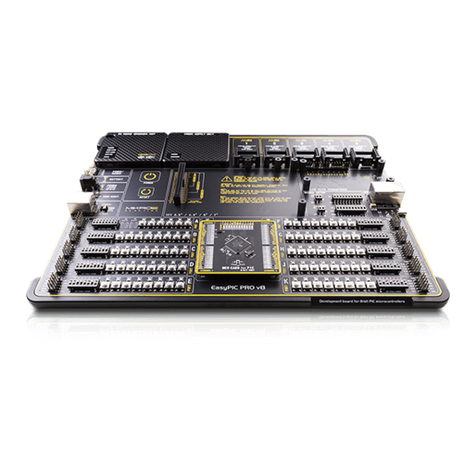
Mikroe
Mikroe EasyPIC PRO v8 User manual
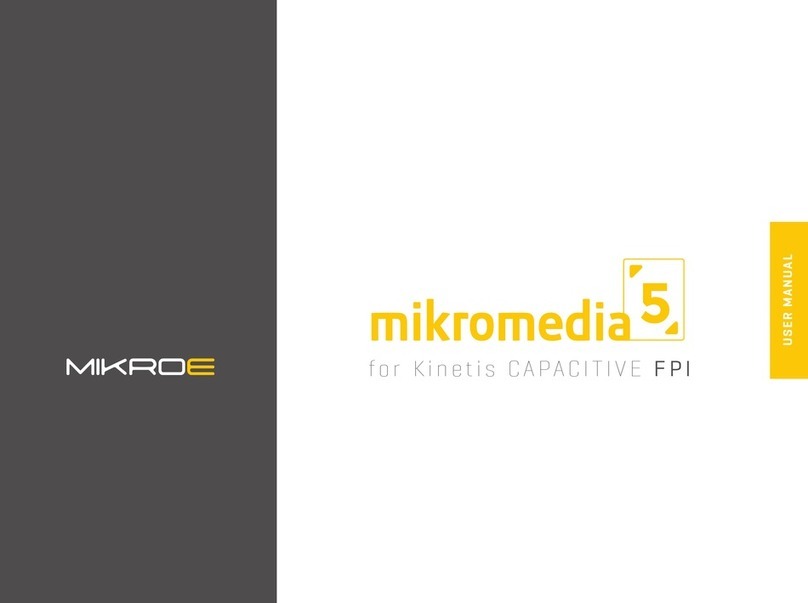
Mikroe
Mikroe mikromedia 5 User manual
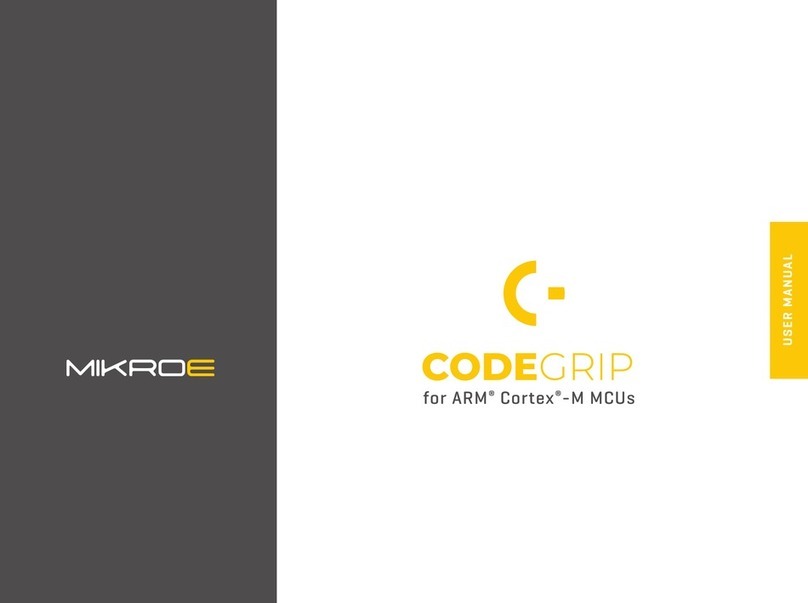
Mikroe
Mikroe Codegrip User manual
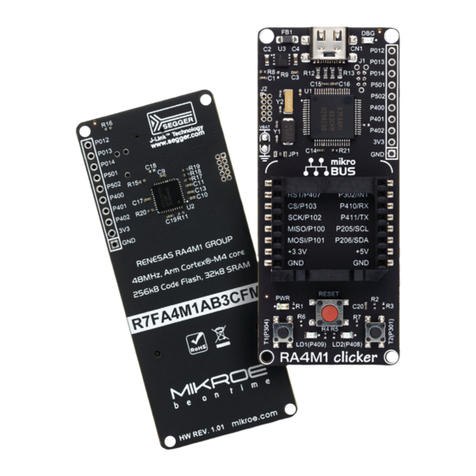
Mikroe
Mikroe RA4M1 CLICKER User manual
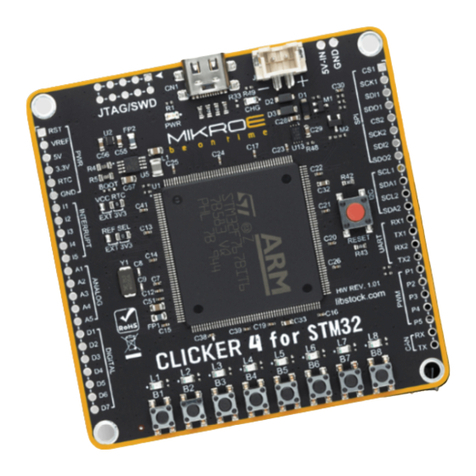
Mikroe
Mikroe CLICKER 4 for STM32 User manual
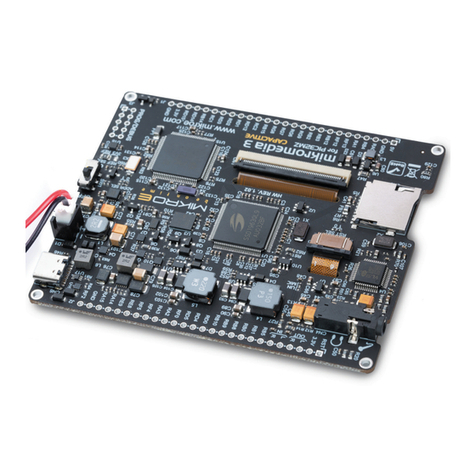
Mikroe
Mikroe mikromedia 3 User manual

Mikroe
Mikroe EasyPIC V8 User manual
